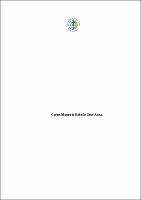Please use this identifier to cite or link to this item:
https://rima.ufrrj.br/jspui/handle/20.500.14407/14632| Tipo do documento: | Dissertação |
| Title: | Estudo da interação entre albuminas séricas e moléculas biologicamente ativas |
| Other Titles: | A study of the interaction between serum albumins and biologically active molecules |
| Authors: | Chaves, Otávio Augusto |
| Orientador(a): | Ferreira, Aurélio Baird Buarque |
| Primeiro coorientador: | Sant'Anna, Carlos Maurício Rabello |
| Segundo coorientador: | Cesarin -Sobrinho, Dari |
| Primeiro membro da banca: | Salles, Cristiane Martins Cardoso |
| Segundo membro da banca: | Garden, Nanci Câmara de Lucas |
| Terceiro membro da banca: | Riger, Cristiano Jorge |
| Quarto membro da banca: | Correa, Rodrigo José |
| Keywords: | Albumina sérica;produtos naturais;espectroscopia;ancoramento molecular;Serum albumin;natural product;spectroscopy;molecular docking |
| Área(s) do CNPq: | Química |
| Idioma: | por |
| Issue Date: | 19-Jul-2016 |
| Publisher: | Universidade Federal Rural do Rio de Janeiro |
| Sigla da instituição: | UFRRJ |
| Departamento: | Instituto de Ciências Exatas |
| Programa: | Programa de Pós-Graduação em Química |
| Citation: | CHAVES, Otávio Augusto. Estudo da interação entre albuminas séricas e moléculas biologicamente ativas. 2016. 109 f. Dissertação (Mestrado em Química) - Instituto de Ciências Exatas, Universidade Federal Rural do Rio de Janeiro, Seropédica - RJ, 2016. |
| Abstract: | As interações entre albumina sérica humana (ASH) com 18-FP, BZL, MTZ e MZ e entre albumina sérica bovina (ASB) com t-DCTN, PF, LF-B, PIA e α-lap foram estudadas por técnicas espectroscópicas (absorção molecular no UV-Vis, dicroísmo circular, emissão de fluorescência no estado estacionário e com resolução temporal) sobre condições fisiológicas. Cálculos teóricos por ancoramento molecular (do inglês molecular docking) foram executados para complementação dos dados experimentais e dessa forma obter resultados mais precisos. Os resultados obtidos para as constantes de velocidade de supressão de fluorescência das albuminas (kq) são maiores do que a velocidade de difusão em água (kdiff ≈ 5,00x109 L/mols), indicando que há formação de um complexo no estado fundamental entre as albuminas com as moléculas biologicamente ativas (para amostra PIA tal dado foi confirmado com a fluorescência resolvida no tempo). Para as amostras t-DCTN e LF-B além do mecanismo estático foi observado à presença do mecanismo dinâmico e já para as amostras PF e PIA o cálculo de Förster mostra alta probabilidade de ocorrência de transferência de energia entre o fluoróforo e os supressores. Os valores termodinâmicos de energia livre de Gibbs, calculados para todas as amostras estão de acordo com a espontaneidade da associação. Parâmetros termodinâmicos de ΔH° e ΔS° forneceram indícios das principais interações intermoleculares na associação. As amostras 18-FP, t-DCTN, LF-B, PIA, α-lap, BZL e MTZ associam com a albumina via ligação de hidrogênio e interações hidrofóbicas e já PF e MZ por ligação de hidrogênio e interações eletrostáticas. O número de sítios de ligação para todas as amostras indicam que há apenas uma principal cavidade da proteína para a associação das moléculas estudadas, sendo que essa associação é moderada para 18-FP, PF e LF-B, fraca para t-DCTN e forte para PIA, α-lap, BZL, MTZ e MZ. Estudos de dicroísmo circular demonstram que não há perturbações significativas na estrutura secundária da albumina com a associação. Cálculos teóricos via ancoramento molecular estão em total acordo com os resultados espectroscópicos |
| Abstract: | The interactions between human serum albumin (HSA) with 18-PF, BZL, MTZ and MZ and between bovine serum albumin (BSA) with t-DCTN, PF, LF-B, PIA and α-lap were studied by spectroscopic techniques (molecular absorption in the UV-Vis region, circular dichroism, emission fluorescence in the steady state and temporal resolution) under physiological conditions. Theoretical calculations by molecular docking were performed to complement the experimental data and thus offer accurate to the results. The results obtained for the fluorescence quenching rate constant (kq) is greater than the diffusion rate constant in water (kdiff ≈ 5,00x109 L/mol), indicating that there is formation of complex between albumin and biologically active molecules in the ground state (for the sample PIA we confirmed this data with time resolved fluorescence experiments). For t-DCTN and LF-B beyond the static mechanism it was observed the presence of dynamic fluorescence quenching mechanism. Finally, for PF and PIA Förster theory shows that the energy transfer between the fluorophore and the quenchers can occurs with high probability. The thermodynamic values for Gibbs’ free energy are in accordance with the spontaneity of the association, for all the samples. Thermodynamic parameters ΔH° and ΔS° provided evidence of the main intermolecular interactions in the association. The samples 18-FP, t-DCTN, LF-B, PIA, α-lap, BZL and MTZ interact with albumin by hydrogen bonding and hydrophobic interactions. On the other hand, PF and MZ interact by hydrogen bonding and electrostatic forces. The number of binding sites shows that there is only one main cavity of the protein to the interaction. For 18-PF, PF and LF-B the binding is weak, for t-DCTN the binding is moderate and for PIA, α-lap, BZL, MTZ and MZ the binding is strong. Circular dichroism results show that upon binding of samples with the albumin there are no significant perturbations on the secondary structure of the protein. Theoretical calculations by molecular docking are in full agreement with the spectroscopic results |
| URI: | https://rima.ufrrj.br/jspui/handle/20.500.14407/14632 |
| Appears in Collections: | Mestrado em Química |
Se for cadastrado no RIMA, poderá receber informações por email.
Se ainda não tem uma conta, cadastre-se aqui!
Files in This Item:
| File | Description | Size | Format | |
|---|---|---|---|---|
| 2016 - Otavio Augusto Chaves.pdf | 2016 - Otavio Augusto Chaves | 6.15 MB | Adobe PDF |  View/Open |
Items in DSpace are protected by copyright, with all rights reserved, unless otherwise indicated.

